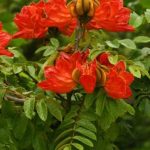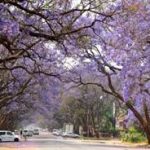TREE LIFE
August 2016
MASHONALAND CALENDAR
Saturday 6th August: Botanic Garden Walk. Meet in the car park at 0845 to start at 0900 hours. Always something of interest, always something special to see and it might be getting a bit warmer.
Sunday August 21st : Outing to the Alexander’s property, Ruwa. We have been invited by Jo and Tony to visit their property in Ruwa and it promises to be a good day. Meet at Mukuvisi Woodlands car park at 0830 for an 0845 hour departure.
Saturday 27th August: St George’s College gardens. We are again invited to St George’s College to further explore the beautiful gardens there. Meet in the car park at 1415 for a 1430 start. We are grateful to the Headmaster for allowing us to visit this interesting site again.
PLANTED TREES OF HARARE -Bauhinia purpurea
Family Fabaceae – Caesalpinioideae (Purple Bauhinia, Orchid or Butterfly Tree).
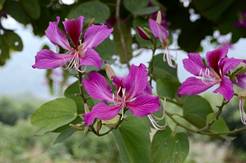
Bauhinia purpurea flowers
Bauhinia purpurea is a plant of tropical and subtropical climates, native to East and South-East Asia (Bangladesh, Bhutan, China, India, Indonesia, Japan, Malaysia, Myanmar, Nepal, Pakistan, Sri Lanka, Taiwan and Thailand), usually growing where the rainfall is between 800 and 5000mm, at altitudes of between 500 and 3000m and where the mean annual temperature is between 12 and 21C. The tree is naturally found in most types of vegetation, ranging from evergreen lowland rainforest to mountain forest and savanna, scrub and dry deciduous forest, to swamp forest and on various soils – sandy, loamy or gravelly. The growth rate is relatively good at lower altitudes but slows down above 1600m. It grows well at lower elevations and is especially frequent along valleys in its native habitat. It demands plenty of light and requires good drainage. Severe frost kills the leaves of seedlings and saplings, but they recover during summer. Once established the species is frost-hardy but is the least drought-hardy compared to other species of Bauhinia.
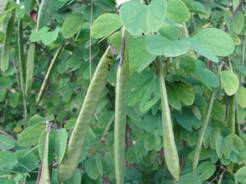
Bauhinia purpurea pods
It is widely planted as an ornamental tree in parks, gardens and homesteads and along avenues for its showy fragrant, purple flowers. However, the weak wood of the branches is susceptible to breakage in storms and it has been found to be weedy in wetter areas such as Hawaii. Interestingly, the tree flowers best on drier soils.
The generic name commemorates the Bauhin brothers Jean (1541-1613) and Gaspard (1560-1624), Swiss botanists. The two lobes of the leaf exemplify the two brothers. The specific name refers to the purple colour of the flowers. There are about 300 species of the genus Bauhinia found in tropical regions, which includes trees, vines, and shrubs that are frequently planted for their showy flowers and ornamental foliage. Unusually, stomata are found on the seeds and pods.
Bauhinia purpurea is a small to medium-sized deciduous fast-growing shrub or tree with a round, symmetrical, moderately dense crown to 10m tall, young branches becoming glabrous or nearly so (glabrescent). In dry areas the size is much smaller. The bark is pale grey brown, fairly smooth to slightly fissured and scaly. The heartwood is brown, hard and durable. In its natural habitat the tree is deciduous, flowering from September to November when the plant is leafless. The tree starts flowering at an early age of 2-3 years.
The leaves are simple and alternate, with a rounded to shallow-cordate base and deeply 2-lobed at the apex. They can grow up to 12 cm x 12 cm with margin entire and surfaces smooth and glabrous. to sub-acute surfaces. There are minute stipules 1-2 mm long and the petioles are puberulous to glabrous, 2.5-3.5 cm.
The inflorescence is a 6-10-flowered raceme in terminal panicles, with clavate (club-shaped) buds. The flowers are numerous, purple to nearly white or at least purple- marked, velvety, ca 3-4 cm long. The flowers are followed by long, slender, brown, flat, seed pods.
Uses: The young leaves and flowers of various Bauhinia species are eaten in Asia as a side dish with rice, or used to flavour meat and fish. The leaves make good animal fodder and are greedily eaten by sheep, goats and cattle, with a protein content estimated at 12.6%. In an experiment in Nepal, B. purpurea was found to increase milk production by lactating buffaloes.
The bark of Bauhinia is used to make rope and contains considerable amounts of tannin, which in the past was widely used in the leather industry. The medicinal uses of the bark can be largely attributed to the presence of these tannins – poulticing to reduce swelling and bruises and to ripen ulcerations and boils. In India, the bark is extensively used for glandular diseases and as a poison antidote, while the leaves are administered as a cough medicine. The flowers are said to be laxative and are used in curries and pickles, while the tree yields an edible gum. The wood is used both as fuel and for agricultural implements. Bauhinia purpurea, with its deep root system and high root: shoot ratio, is a suitable species for slope stabilisation. The tree coppices well and can stand heavy lopping.
Reference:
Orwa, C., Mutua, A., Kindt, R., Jamnadass, R., Anthony, S., 2009. Agroforestree Database: a tree reference and selection guide version 4.0. World Agroforestry Centre, Kenya.
– Isla Grundy
OUTING TO UNIVERSITY OF ZIMBABWE, 25TH JUNE, 2016
This walk was organised by Clare Griffiths and led by Tony Alegria. The object of the visit was to label with numbers the trees we found in the grounds of the University of Zimbabwe.
We started in the Pharmacy Department car park and in the first stage of the afternoon we walked down towards the Churchill Avenue entrance gate. A plan to investigate the vlei area that runs parallel to Churchill Avenue was not pursued because the grass was ‘as high as an elephant’s eye’; exploring that area was left to another day.
So, unusually for a Tree Society walk, we mostly looked at the trees which had been planted in the University grounds, which were mainly exotics, but which did include some native trees as well. I also kept an eye open for any herbaceous plants of interest.
There were a great number of planted Ash trees (of the genus Fraxinus) some of which were escaping into the stream bed. This species is naturalised fairly commonly around Harare and the exact name has been uncertain the past; however, based on the nearly glabrous undersides of the leaves, I am more confident now in naming it Fraxinus americana.
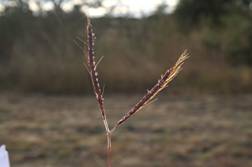
Grass – Dichanthium aristatum
This area of the university also features a rather unusual introduced grass, Dichanthium aristatum. I knew it was there, as I was shown it by Kay Bennett in March 1985 (31 years ago) and there is a great deal of it still. It is
easily recognised by the hairiness of the inflorescence that extends a short way down the culm.
Another unusual species, probably also an introduction, was Sesbania sesban. This is one of the few species of Sesbania which can actually be called a tree. There were two specimens there, one with a quite imposing trunk. It’s not native to this part of Zimbabwe so I imagine it must have been planted.
Also along the stream side was a lot of the escaped Bauhinia variegata; again, commonly to be seen in the ditches of Harare. Amongst some disturbed ground was a plant of the Bulrush millet, also known as Munga and nearby, for comparison, were the inflorescences of actual bulrushes, Typha capensis. The two are extremely similar proving the validity of the name Bulrush millet. The Bulrush millet has undergone another name change; I first learnt is as Pennisetum americanum, later it became Pennisetum glaucum. However, now the genus Pennisetum has been sunk into Cenchrus and the name is now Cenchrus spicatus.
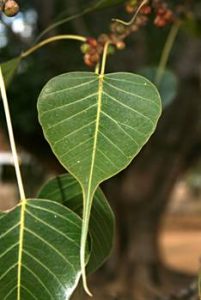
Ficus religiosa leaf
As the afternoon shadows were lengthening, a small group of enthusiasts drove to another part of the university and investigated another batch of cultivated species. There we came across a number of colonies of Mimosa pudica, a ‘sensitive’ plant, which folds up its leaves when touched.
One of the most distinctive figs grown in Harare is Ficus religiosa, which has an extraordinarily long-extended tip. It also escapes (is it bird sown?) and small plants crop up from time to time around the city, typically in cracks in pavements. Here too a couple of small plants had managed to escape from their parent and were growing at the base of a wall. Two other species were also found, Ficus benjamina and Ficus microcarpa.
All in all it was an interesting afternoon. A number of trees remained unidentified and a return visit would be of great interest.
– Mark Hyde
OUTING TO HAKA PARK 23RD JULY 2016
A gloriously warm afternoon, after a very long chilly wintery spell, was the reward for joining the Tree Society outing to Haka Park. The vleis had been mown and wildebeest, eland and zebra were taking advantage of the warmth and were basking in the sunshine. Some tree species were sprouting new growth – a sure sign of spring coming, says our Meg.
We chose to make Camp Site 2 our venue for the afternoon and what a haven of biodiversity it is, with many species reaching fair size as a result of a good water supply (from Cleveland Dam) and protection from fire and chopping.
On the drive down from the main gate to the camp site we stopped to look at two oak trees, Quercus sp. resplendent in their autumn colours – quite amazing that all over the world at this time of year, the Oak is giving pleasure to all who are engaged with the changing seasons, so beautiful. We pondered on who might have planted these trees to “remind them of the old country” – this area was all municipal park surrounding Cleveland Dam which was Harare’s first main water supply. We speculated that Ronnie James – a name from the past and always associated with being responsible for the beautification of our City’s parks and gardens – could have been responsible. Mark identified the one Quercus as Quercus acutissima but the other remained Quercus sp! At the same spot we admired a magnificent Albizia antunesiana and nearby a tree festooned with the parasitic climber Globimetula mweroensis, Family Loranthanceae, a brilliant red display in the rather dry, drab woodland.
A light hearted, very cheerful stroll around the camp site revealed Flacourtia indica, Governor’s Plum, still with berries, enjoyed by some; Gymnosporia senegalensis and Ochna pulchra, Peeling bark Ochna, which will soon be bearing its pale yellow, sweetly scented, very short-lived flowers with the advent of spring. I feel sure that Meg was relieved when we were able to correctly identify Ozoroa reticulata, Tar Berry, from her key – we need to become more au fait with how to use this key, and of course, it helps when you know what the tree is anyway!
Much debate followed on Grewia decemovulata, until Frances identified it on the Flora of Zimbabwe site, recorded by Mark Hyde and Burt Wursten at Cleveland Dam. It was probably the very same bush. Nearby was a young Securidaca longipedunculata, my very favourite Violet Tree, most of us there had tried to grow our own Securidaca without success. This one needs to be watched to see if we can get any seeds from it. There was also a fair sized Pavetta schumanniana, Poison Bride’s Bush. At Henry Hallam Dam last Sunday Ann Sinclair was telling us of her experience with this tree and goats – when it is eaten by goats, at first the goat shows no sign of distress, but if the animal suffers any kind of shock or stress, it falls down dead. There is also a case where three buffalo were translocated from Mutirikwe Recreational Park who died on translocation. The buffalo had had access to Pavetta schumanniana, a plant that is known to cause gousiekte. Death was attributed to cardiac failure as a result of previous consumption of the plant, exacerbated by the stress of translocation. What a lot of things one picks up on a Tree Society Saturday afternoon stroll. Next was Swartzia madagascariensis, Snake Bean Tree, with a lovely twisty snake bean pod, and now called Bobgunnia madagasariensis, Fabaceae family, also has a poisonous seed. A poisonous mixture, composed of the roasted seeds of Bobgunnia madagascariensis and the innards of the beetle Diampidia nigrornata, was applied to the arrows of the Bushmen before their hunting trips. Seeds, fruits and stem bark are also used in fishing by poisoning in Africa. And yet the pods are eagerly eaten by cattle.
We also recorded Psorospermum febrifugum, Christmas Berry, a lovely specimen which also will be worth coming to see when it is full of berries; Cussonia arborea and Pavetta gardeniifolia, Stink leaf Bride’s Bush.
Shadows were lengthening and chill was setting in, so we called it a day. I think all those there: Mark, Meg, Tony, Pete, Frances, Jan, Bilal, Margaret, Kari, Erica and Graham and Mary enjoyed it “muchly”. A lovely venue which we are lucky to have preserved so close to home.
– Mary Lovemore
FLAMES OF CONTROVERSY (1988)
Visitors to the United States National Parks have a duty to prevent forest fires. Some scientists now believe it is a ranger’s duty to start them.
The forest fills with the roar and crackling of burning wood. Orange flames blacken a stand of rare, giant sequoia trees as the forest fire races towards a nearby meadow. A park ranger waits patiently for the fire to reach the meadow and burn itself out. In her hand is the incendiary device she used to light the fire. The scene would horrify most Americans who have been taught since an early age to prevent forest fires. There were good reasons for this. The number of tourists in the areas of wilderness in the US rose dramatically during the 1950s. They caused large numbers of forest fires, destroying vast areas of valuable timber.
To fight the menace, the US Forest Service launched an intensive campaign to make people more careful with fire in forests. The campaign spawned one of the most successful advertising gimmicks ever, the cartoon character, Smokey Bear. With his shovel, ranger’s hat and injection to “Remember, only YOU can prevent forest fires” Smokey firmly fixed in the American mind the conviction that forest fires are bad.
But scientists have since discovered that forests, which evolved to deal with regular fires caused by lightning, need to be burned occasionally to remain healthy. American forestry officials are now having to persuade the public that some forest fires are good.
Not everyone is convinced. Forest fires are terrifying while they are happening and leave ugly scars. They are not nearly as easy to sell to the public as Smokey Bear. This year, as American suffers from a severe drought, the issue of deliberate forest fires has blazed into public awareness. Politicians are now pitted against foresters in a misplaced effort to save trees that could eventually destroy many American forests.
Patti Haggerty, a fire monitor at Sequoia National Park, California, explains the history of the debate: “From the early years of the Parks Service in the last century to around 1968, it had been policy to quench all fires that started on park lands whether the fire was man – made or a natural lightning fire. This lack of fire for 80 years or so in areas that usually burned on the average every seven to ten years, has allowed huge amounts of underbrush and fallen trees to develop beneath existing stands of trees. If a fire were to catch in these regions it would burn very hot and would destroy even the very large trees. Control burning is used to keep this from happening.” Once a forest area is designated for a control, or prescribed, fire, some of the larger fallen trees are removed and smaller trees cut down. This will prevent the fire from burning too hot and getting out of control.
The first controlled fires in Sequoa National Park took place in 1968, but the idea is far from new. In 1891 early settlers in the Sequoia region proudly claimed that they had saved a grove of sequoias from burning 29 times in just five years. Gifford Pinchot, the director of the Forest Service at the time, responded “Who then saved them during the remaining three or four thousand years of their age?”
Pinchot, though clearly ahead of his time, had no authority to set a fire policy for the national parks, which are separate from the Forest Service. The purpose of the parks was to serve the people and blackened forest did little in this regard. So a strong programme of defence against forest fires was part of every park director’s policy until the 1960’s, when the Parks Service changed its thinking. In 1963 a commission that came to be known as the Leopold Panel proposed that the decades of stopping and preventing fires in forests may have caused much more harm than good.
The panel made two recommendations. The first was that park and forest officials should begin controlled fires to restore the levels of fuel in the forest to those of the last century. The second recommendation was to allow fires caused by lightning to burn without interference until they either burned themselves out or threatened human life, buildings, or private property. This report started the rethink of fire policy in America.
Fire is now considered by most people charged with managing wilderness areas as a natural process that serves a vital ecological purpose within a forest. Most parks now let natural fires burn whenever possible, and they also use some controlled burning. Fire is no longer considered the harbinger of destruction that it once was. Some would say it is nature’s cleaning process; ridding the forest floor of years of debris. This debris hinders the growth of new trees and, it accumulates in large enough quantities, leads to large, uncontrollable crown fires. These fires reach the tops of the trees and can damage a forest severely. It may take decades for a forest to recover from a crown fire and the area is very susceptible to erosion in the meantime.
Most fires do not reach the crowns of the trees, however, and they actually help to prevent such catastrophic burns. Most kill only smaller trees and shrubs and allow seedlings from the larger trees to germinate. Most large tree species cannot thrive in the shade and do not grow well under heavy undergrowth. Without occasional fires to clear this undergrowth, fewer of the larger trees will grow.
The most striking example of a species which is dependent on fires is the Sequoiadendron giganteum or giant sequoia. This majestic tree once grew almost everywhere in North America but now can be found only in a few small pockets in the Sierra Nevada of California.
The sequoia is the world’s largest living thing and is well adapted to environments where forest fires are common. The bark of the huge tree is often up to 30cm thick and insulates the tree from the heat of a fire. This bark chars very easily but the tree is undamaged in most cases.
Fire is vital to the reproduction of sequoias. The cones of the trees are serotinous, which means they remain closed after maturing and may stay that way for up to 20 years. The heat of the fire often opens these cones and the seeds fall onto the forest floor at several times the normal rate in the days after the fire. The scorched ground is ideal for sequoia seeds to germinate because it is free of the fungi which kill the seeds and it has a high mineral content.
The effect of a forest fire on the germination of sequoia seeds is profound, as Patti Haggerty explains “If you go into a sequoia grove where fires have been suppressed for a long time, you will see very few young sequoia trees, if any at all. However, just a few months after a fire, there are sequoia seedlings cropping up by the hundreds. However, the mortality rate of young sequoia seedlings is very high.”
One of the main jobs of those like Patti Haggerty who manage fires is to decide when to light a controlled burn. They use computers to help to determine when to burn an area. The calculations are based on the amounts of, among other things, woody debris, soil, organic matter and moisture in the area. Weather conditions are also included. The computer is also used to predict the fuel dynamics as well as the behaviour of the fire.
Most controlled fires take place in regions with relatively high populations of residents and visitors. This is because these areas must be well protected from catastrophic fires and controlled burning reduces the risk. In the process it creates a healthier forest but gives the appearance of utter destruction.
Because of their position the fires draw a lot of attention. Public perception is perhaps the biggest problem facing those who use prescribed burning to manage the forests. Smokey Bear is practically a national institution and forestry officials admit it will take a long time to teach the public that fires can be good for a forest. Television and newspapers still treat fires in a generally negative manner. Smokey Bear is still not obsolete. His purpose has always been to deter the public from starting forest fires. Such fires tend to be the most damaging to property and to human life because they are almost always started in relatively densely inhabited areas.
The second major recommendation of the Leopold Panel has resulted in the “let it burn” policy towards natural fires. The Parks Service supports this approach but it has created problems for staff. In many areas there is a century’s worth of undergrowth. It would be very difficult for the service to start a controlled fire without the risk of huge destructive blazes, harmful to both humans and forest. The transition back to an environment in which fires are natural will not be easy.
Another major problem is that of fires crossing park boundaries. Wilderness areas in the US are owned by several different government agencies. Besides the Park Service and the Forest Service, the Bureau of Land Management owns millions of hectares of wilderness and there are numerous state-owned parks and forests. The ‘let it burn’ policy requires a lot of communication between these agencies to ensure that fires do not get out of hand. To date that communication does not exist or to any great degree. No one yet knows who is responsible for a prescribed fire that gets out of control and destroys property on private land because it has not yet happened although it remains a potentially serious problem.
The fires this summer (1988), especially those that threatened the historic Old Faithful Lodge in Yellowstone National Park, Wyoming, have high lighted the conflict between the public’s interests and the park’s fire policy. The high fuel levels coupled with intense heat and drought brought an unprecedented risk of fire. The ‘let it burn’ policy is getting its first full public scrutiny as newspapers bring coverage of fires to the front page.
The pressure on park and forest management has been especially intense in the Yellowstone area. Many people there make their living as guides for hunting and rafting excursions. These people say that the fires are keeping visitors out of the forest and are ruining their businesses. In addition, coverage on national television has given the impression that the whole of Yellowstone Park is going up in flames. Such media attention has sparked public outcries over why the Parks Service is not doing anything about it. The matter was finally taken out of the hands of Yellowstone officials when Don Hodel, the Secretary of the Interior, whose department runs the Parks Service, decided that, for the time being, all further fires in the park should be quenched and that the ‘let it burn’ policy would be re-examined.
The 1988 drought in the US put prescribed fires and the “let it burn” policy on hold. Many foresters, however, felt it would be wrong to back down from the policies in the face of media attention.
Most people who have to deal with forest fires believe that public education about the benefits of fire will turn popular opinion. Bob Barbee, Yellowstone’s superintendent says “Charred forests are hard to sell. Right now it looks like a war took place. But in a few years, it will be a carpet of new growth”.
During the fires at Yellowstone Park workers handed out notes to visitors stating that they were lucky to witness this natural event but the visitors were still hooked by the destructive power of the fires.
Patti Haggerty agrees that the sight of a burned forest can be quite appalling. Indeed there are some who are opposed to the programme of controlled fires in sequoia groves for this very reason. However, most feel that the fire policies of the Parks Service will continue despite the objections. As Patti Haggarty put it “For the sake of the big trees, hopefully cooler heads will prevail.”
– JO HAGGERTY
With acknowledgements to New Scientist, 25th August, 1988. Joe Haggerty was then a freelance science writer based in Carisbad, California. In Zimbabwe fire is also good from an ecological perspective, but it is important to note that natural fires occur every five to seven years and the burn will normally be patchy. Annual late burns as we see them today (i.e. burns at the end of the dry season when the fuel load is dry and high) are detrimental to savanna regeneration. – Ed
PRONUNCIATION OF NAMES THAT CONTAIN PHYL ….
Phyl… comes from Greek word phyllon meaning leaf. While I’m highlighting names which begin or end with a derivation of phyl, I’m taking the opportunity to pronounce other names. The correct pronunciation is seldom used and we will go along with how Mark Hyde pronounces the botanical names. The phonetic spelling must be read as in normal English and is as close as we can contrive with the standard alphabet.
Examples of pronunciation of botanical names ending with PHYL…
Allophylus africana ALOE-FIGH-LUSS AF-REE-CAR-NAH
Celtis gomphophylla SELL-TISS GOM-FOE-FILL-AH
Chrysophyllum viridifolium KRYSS-OH-FILL-UM VERR-RID-EE-FOE-LEE-UM
Clerodendrum eriophyllum CLEAR-OH-DEN-DRUM AIR-REE-OH-FILL-UM
Combretum erythrophyllum KOM-BREE-TUM AIR-RITH-THROW-FILL-UM
Combretum microphyllum KOM-BREE-TUM MIKE-ROW-FILL-UM
Maerua triphylla MAY-ROO-AH TRY-FILL-AH
Maytenus heterophylla MAY-TEN-US HETTER-OH-FILL-AH
Ochna cyanophylla OCK-NA SIGH-AN-OH-FILL-AH
Phyllanthus inflatus FIGH-LAN-THUS IN-FLART-US
Tapiphyllum velutinum TAP-EE-FILL-UM VELL-LUTE-TIE-NUM
Tarenna neurophylla TAR-REN-NA NEW-ROW-FILL-AH
Harpephyllum caffrum HARP-ERR-FILL-UM KAFF-RUM
Again I thank Mark Hyde and Dave Hartung for making these articles on pronunciation possible – thanks guys!
– Tony Alegria
TONY ALEGRIA CHAIRMAN


